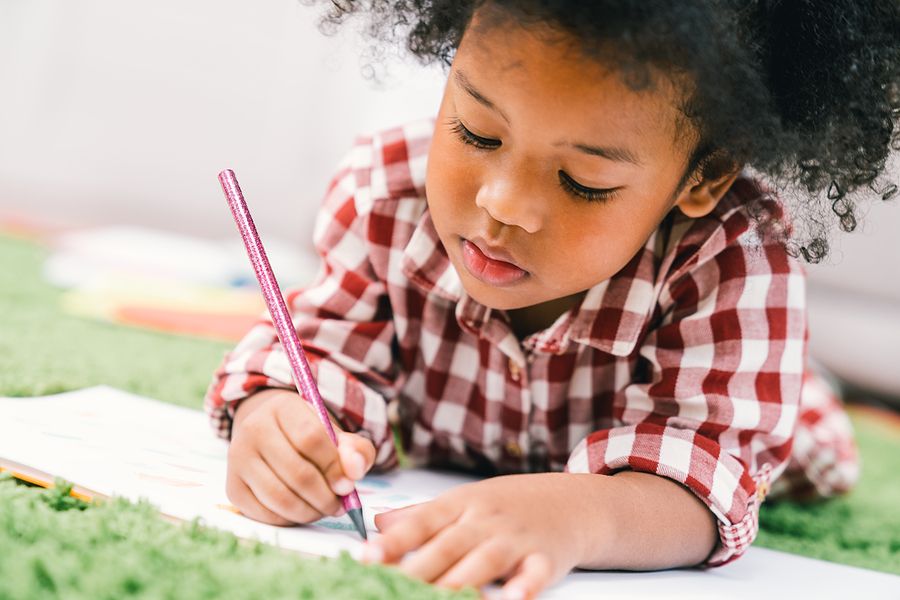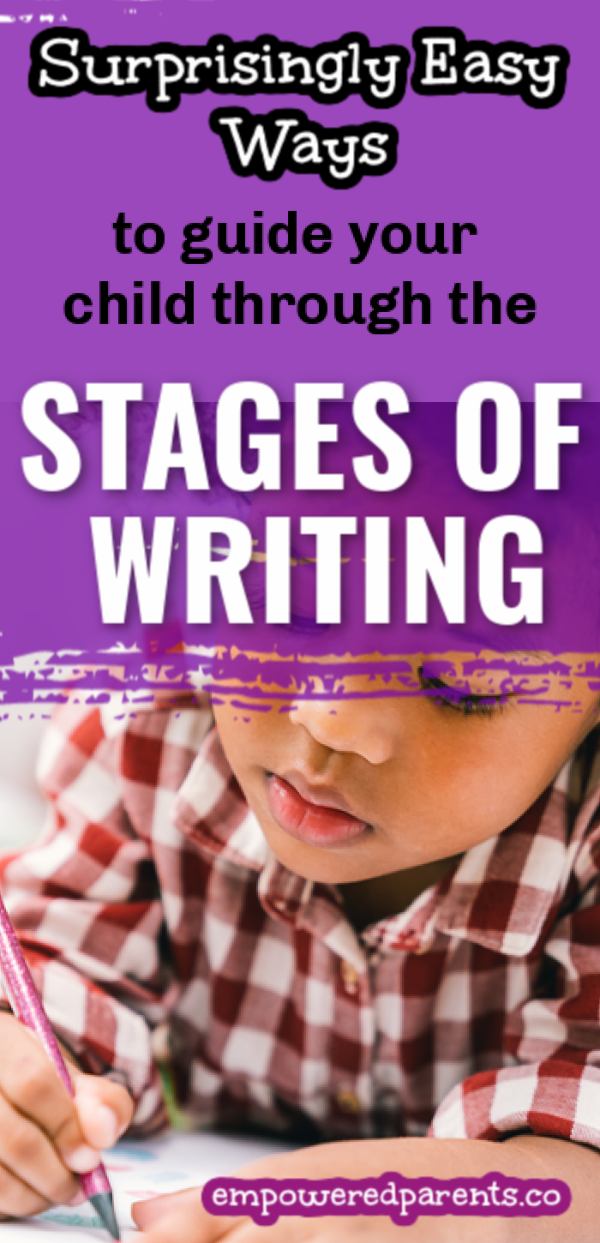Here is a fascinating look at the journey through the six developmental stages of writing and how you can become involved and help facilitate children’s development at home and school.
Through the 1950s, many parents and educators believed the notion that children gain writing skills “when they are ready.” Groundbreaking research and publications on “emergent literacy” by Marie Clay (1926-2007), beginning in the 1960s, turned that on its head.
Her ideas started a revolution of sorts. Ms Clay’s theories have been pursued even further and are supported by current research.
We now understand that children pass through emergent writing stages in their development of skills, beginning with drawing and scribbling, which finally lead to spelling.
This development is based on many factors, and all kids do not necessarily pass through the stages of writing development in early childhood at the same age or grades.

How to Develop Pre-Writing Skills
You can help children attain pre-writing skills through activities such as these:
- Read aloud to children daily, beginning in infancy.
- Recite nursery rhymes and other fun rhyming poems, especially those with repetition.
- Offer fine motor activities, such as building blocks, lacing beads, and cutting practice.
- Make paper and writing instruments available on a regular basis.
- Share your world verbally. Talk to kids about what is happening around you, ask and answer questions.
- Ask your children to tell you about their drawings. You can then add a one-word label or a sentence describing what the picture shows.
- Ask them to “tell a story” about their drawings. Write down the words they dictate.
The 6 Stages of Writing Development
Children share the human desire to represent objects, thoughts, and feelings. This process begins in their drawings and eventually leads to writing.
Although these stages of the writing process sometimes go by different names, depending on your resource, you can expect your children to move through and meet the following types of milestones in their writing development.
1. Drawing
With the use of various tools, children draw pictures of familiar places and objects. They “read” or explain their drawings to you and may tell an entire story about the drawing.
Some drawings feature one main scene, while others show a string of pictures, more like comic book format.
These are the stages of drawing in early childhood.

2. Scribbling
Often referred to as “pre-phonemic,” drawings in this stage sometimes contain scribbles of random lines or circles that look somewhat like letters and can combine with drawings.
Children learn to mimic how adults hold writing tools during this phase. They are learning about left to right progression, which often shows in their scribbling.

3. Creating Letter-Like Forms
Beginning what is sometimes called the “early phonemic” stage, children may choose to ignore drawing to focus on shapes that look like letters. They commonly incorporate the first letter of their own name.
Children rarely pay attention to spacing in this stage.
4. Reproducing Strings of Random Letters
At this stage, children understand that print carries meaning, they use more “real” letters and pretend to write words.
They often learn how to effectively write their first name during this phase, as well.
Children may even “read” back to you what they have written. They most commonly use capital letters.
These are the steps to teaching a child to write their name.
5. Invented/Transitional Spelling
Spellers in this stage often use single consonants to stand for words, such as “M” for “Mom” or “D” for “Dad.” Beginning and ending sounds emerge, and some children even attempt the middle vowels.
They start to use spaces between letters, write in a sentence-like format based on one idea, and even include some punctuation.
Writers in this phase may use both capital and lower-case letters. They often print familiar names and words (like “dog”) spelt correctly.
6. Standard Spelling
Gaining a wider vocabulary, learners in the standard spelling stage form many words correctly and begin to use and then master proper punctuation.
You can usually read and understand what they have written.

They continue to learn about root words, affixes, and contractions to fit their evolving writing needs.
Ways to Encourage Writing Development in Each Stage
Here are some simple tips to encourage early writing development at various ages.
During the drawing and scribbling stages:
- Labelling common objects around the house is helpful.
- Always make sure to offer a variety of drawing papers, writing/art tools: pencils (skinny and fat), coloured pencils, crayons, paints, and washable markers. Inexpensive paper options include newsprint and paper grocery bags.
- Offer plenty of encouragement in these early phases.

In the letter-like forms and strings stages:
- Point to individual words as you read to your children. This helps with left-to-right progression and one-to-one correspondence with words.
- Allow them to turn the pages when they see you have come to the end.
- Use “big books” in settings with more than a few listeners so that everyone can see the book. In this case, kids can take turns, from one book to the next, turning pages.
- You can also try writing big books with your children about a shared activity or event.
For the invented/transitional phases:
- Play games with your children where they match letters to sounds.
- Use photos as “story starters” and urge kids to write stories about them.
- Create a “word wall” in your child’s bedroom or playroom with familiar sight words and names of people they know.
As children transition into the standard spelling stage:
- Focus on various reasons for writing beyond stories, such as lists, letters, journals, and greeting cards.
- Kids often become focused on spelling the words “right.” To avoid some need for adult help, offer sets of common word cards (with or without photos, depending on their development), which they can refer to, or make sure those types of words are displayed on their word wall.
- Show your budding authors how to choose topics for their writing.
Finally, for all stages and ages, remember to model the positive characteristics of writers and readers in your own daily routine. This reinforces the idea that parents place a high value on literary activities.
Read more about the 17 early literacy skills in childhood.
Source:
Clay, M. 2010. How Very Young Children Explore Writing. Heinemann: New Hampshire.

